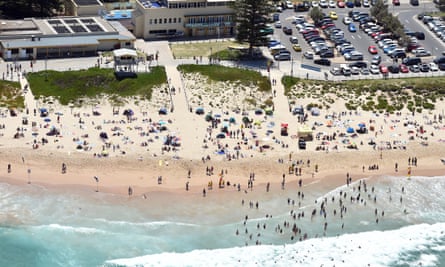Part of Cronulla beach has been closed to the public for safety reasons after a lifeguard tower was left teetering on a cliff edge and had to be relocated, after constant huge swells eroded the beach.
Weeks of rain and wild weather have severely eroded beaches in some coastal regions of New South Wales.
Some of the worst hits areas were Sydney’s Cronulla and North Maroubra beaches, and Bar Beach in Newcastle.
Wow. This used to be Nth Cronulla beach, and Sth Cronulla is back to bare rock too. I’ve never seen them this bad. What a mess. pic.twitter.com/rYFUcaTMAz
— Dr Darren Saunders (@whereisdaz) July 11, 2022
The tower at Cronulla was craned out on Monday night after the Sutherland council deemed it unsafe, and said any further erosion of the sand bank “would pose an unacceptable risk to the structural integrity” of the tower.

A spokesperson for the council said that extensive works were being done to “address the impact of significant sand erosion” across the shire’s beaches and reassured beach goers that beach safety would not be affected.
“Lifeguards will maintain the same level of visual surveillance as would ordinarily be provided during winter months from the Coastalwatch surf cameras,” said the spokesperson.
North Maroubra, sand has disappeared. pic.twitter.com/vLn9VYwBtj
— Frank Glass (@frankglass74) July 11, 2022
James Mcfadden, a local resident who has lived in the shire for 27 years said he had “never seen the water this high”.
“I spoke to one old fella in his 80’s and he told me he hadn’t seen it like this for decades, the sand usually goes out for a 100 metres at low tide,” he said.
Mcfadden, who was at the beach taking photographs said sand cliff faces had replaced the normal entries to the beach all the way to Kurnell.
Bar Beach Newcastle yesterday. It's all falling apart quickly now. pic.twitter.com/R9VaoaYOtu
— Anna Kissed (@SerafinaLydia) July 11, 2022
Coastal geomorphologist and Professor at the University of Melbourne, David Kennedy said the scenes at Cronulla were “uncharacteristic but not unprecedented” and said the scale of the erosion seen was likely due to the interference of infrastructure in the natural beach process.
“Beaches are counterintuitive. They’re loose piles of sand. But because they are movable obstructions to the water they are great at sort of laying there and acting as a buffer. They are the shock absorbers of the coast,” he said.
“What we’ve done is we’ve removed some of the shocks on the coast, by putting in the seawall, and by doing this we have effectively reduced the beaches resilience to change. Because what we’re protecting is the infrastructure behind the beach and not necessarily the beaches themselves.”
Kennedy said the heavy sea walls on either side of North Cronulla beach likely contributed to the increased erosion of the shore. The sea walls were constructed in 1974 after a similar period of stormy weather eroded the beachfront and threatened the properties and infrastructure that line it.
1974, we all went down to see it pic.twitter.com/tmEJqGZymh
— What a Barry (@BickieCuppaTea) July 11, 2022
“We will most likely see more events such as these as climate change takes its toll, and we get more east coast lows. The problem, of course, is in the last 50 years we have done a massive amount of building on our shorelines, and we’ve actually reduced the natural capacity of the beaches.”
Kennedy admits that there are no easy answers for councils looking to protect their shorefronts. He says a “balancing act between protecting property and protecting the coast” needs to be struck, warning that hard engineering solutions were not always effective.
In Cronulla’s case, Kennedy expects the sand to naturally return to the beach when the current bout of bad weather ends and warns adding further sea walls could make the erosion worse.
“I would expect the sand to come back in that area, if you were to leave it alone. However, the timescale of when it would come back would be harder to predict, and would really depend on the weather”
“The question really will be how long is the council willing to leave it in its current state.”